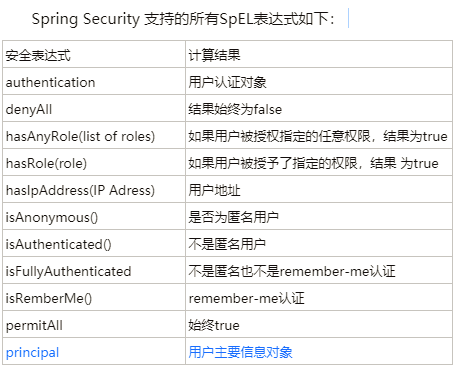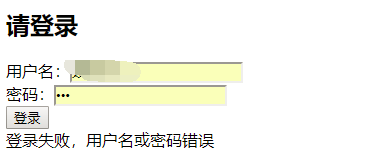Spring Security认识
Spring Security是基于spring的应用程序提供声明式安全保护的安全性框架,它提供了完整的安全性解决方案,能够在web请求级别和方法调用级别
处理身份证验证和授权.它充分使用了依赖注入和面向切面的技术.

下面是我接触Spring Security的第一个小Demo
第一个案例是直接基于内存的,并没有用到数据库的物理表,不过后面也会具体出详细的博客
开发环境:Intellij idea
1.首先引入所需要用到的依赖
<dependency>
<groupId>org.thymeleaf.extras</groupId>
<artifactId>thymeleaf-extras-springsecurity4</artifactId>
</dependency>
<!--spring Security依赖-->
<dependency>
<groupId>org.springframework.boot</groupId>
<artifactId>spring-boot-starter-security</artifactId>
</dependency>
2.SecurityConfig类的编写:
package cn.leon.util; import org.springframework.beans.factory.annotation.Autowired; import org.springframework.security.config.annotation.authentication.builders.AuthenticationManagerBuilder; import org.springframework.security.config.annotation.web.builders.HttpSecurity; import org.springframework.security.config.annotation.web.configuration.EnableWebSecurity; import org.springframework.security.config.annotation.web.configuration.WebSecurityConfigurerAdapter; @EnableWebSecurity public class SecurityConfig extends WebSecurityConfigurerAdapter { @Override protected void configure(HttpSecurity http) throws Exception { http .authorizeRequests() .antMatchers("/css/**","/js/**","/fonts/**", "/index").permitAll() //都可以访问 .antMatchers("/users/**").hasRole("ADMIN") //需要相应的角色才能访问 .and() .formLogin() //基于Form表单登录验证 .loginPage("/login") //自定义登录信息 .failureUrl("/login-error"); } @Autowired public void configureGlobal(AuthenticationManagerBuilder auth) throws Exception { auth .inMemoryAuthentication() //认证信息存储在内存中 .passwordEncoder(new MyPasswordEncoder())//在此处应用自定义PasswordEncoder .withUser("leon").password("123").roles("ADMIN"); } }
3.自定义一个MyPasswordEncoder
package cn.leon.util; import org.springframework.security.crypto.password.PasswordEncoder; public class MyPasswordEncoder implements PasswordEncoder { @Override public String encode(CharSequence arg0) { return arg0.toString(); } @Override public boolean matches(CharSequence arg0, String arg1) { return arg1.equals(arg0.toString()); } }
4.Controller编写
package cn.leon.controller; import org.springframework.stereotype.Controller; import org.springframework.ui.Model; import org.springframework.web.bind.annotation.GetMapping; import org.springframework.web.bind.annotation.RequestMapping; @Controller public class MainController { /* @GetMapping("/") public String root(){ return "redirect:/index"; }*/ @GetMapping("/index") public String index(){ return "index"; } @GetMapping("/login") public String login(){ return "login"; } @GetMapping("/login-error") public String loginError(Model model){ model.addAttribute("loginError",true); model.addAttribute("errorMsg","登录失败,用户名或密码错误"); return "login"; } }
UI界面:
login.html
<!DOCTYPE html> <html xmlns="http://www.w3.org/1999/xhtml" xmlns:th="http://www.thymeleaf.org" xmlns:sec="http://www.thymeleaf.org/thymeleaf-extras-springsecurity3" > <meta charset="UTF-8"> <title>登录</title> <script type="text/javascript" th:src="@{/js/jquery-1.8.3.min.js}"></script> <script type="text/javascript"> </script> </head> <body> <div> <form th:action="@{/login}" method="post"> <h2>请登录</h2> 用户名:<input name="username" type="text"/><br/> 密码:<input name="password" type="password"/><br/> <input type="submit" value="登录"/><br/> <div th:if="${loginError}"></div> <div th:text="${errorMsg}"></div> </form> </div> </body> </html>
index.html
<!DOCTYPE html> <html xmlns="http://www.w3.org/1999/xhtml" xmlns:th="http://www.thymeleaf.org" xmlns:sec="http://www.thymeleaf.org/thymeleaf-extras-springsecurity4" > <head> <meta charset="UTF-8"> <title>博客系统</title> <script type="text/javascript" th:src="@{/js/jquery-1.8.3.min.js}"></script> <script type="text/javascript"> </script> </head> <body> <div> <div sec:authorize="isAuthenticated()"> <p>登录的用户名为:<span sec:authentication="name"></span></p> <p>登录的角色为:<span sec:authentication="principal.authorities"></span></p> </div> <div sec:authorize="isAnonymous()"> <p>未登录</p> </div> </div> </body> </html>
最后我们走一遍测试数据 如果成功的话就是下图:会展示登陆的用户名字和对应的权限信息

如果是失败:
